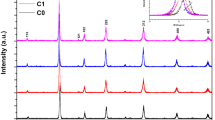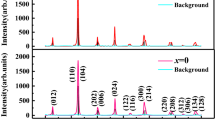Abstract
The electrical resistivity ρ and magnetization of La0.8Ca0.2MnO3.06, (La0.8Ca0.2)0.975MnO3.01, and La0.8Ca0.2Mn0.975O3.06 polycrystalline samples have been measured in magnetic fields 0 ≤ H ≤ 9 T at temperatures in the range 2 ≤ T ≤ 300 K. The results obtained for the first and second samples are typical of manganites with the colossal magnetoresistance effect: the electrical resistivity increases with a decrease in temperature to T ≈ T C and then sharply decreases. The composition of the third sample differs from the composition of the first sample by the content of Mn vacancies, which is ∼2.5% higher in the former case, and this difference leads to a very strong difference in the properties of the samples. First, the ferromagnetism in the third sample is almost completely suppressed and, at low temperatures (T ∼ 50–70 K), there occurs a transition to the state close to the cluster glass state. Second, the electrical resistivity of the third sample at low temperatures and H = 0 is four orders of magnitude higher than that of the first sample, even though the third sample contains a considerably higher concentration of holes. It has been shown that, for all three samples over the entire temperature range under investigation, the local activation energy E depends on the magnetic field. Of particular interest is the fact that the local activation energy E significantly decreases with increasing field in the paramagnetic region, which is not typical of conventional semiconductors. These specific features of the properties of the samples have been explained by assuming the hypothesis according to which holes in all three samples can be in the form of Mn4+, as well as in the form of O−, and can transform into each other. It has been concluded that a decrease in the temperature T and an increase in the magnetic field H favor the formation of Mn4+ holes and result in a decrease in the values of ρ and E with the formation of the ferromagnetic order, whereas an increase in the content of vacancies in the Mn-sublattice favors the formation of O- holes and leads to an increase in the electrical resistivity ρ and the suppression of ferromagnetism in the sample.
Similar content being viewed by others
References
E. Dagotto, Nanoscale Phase Separation and Colossal Magnetoresistance: The Physics of Manganites and Related Compounds (Springer-Verlag, Berlin, 2002).
J. Zaanen, G. A. Sawatzky, and J. W. Allen, Phys. Rev. Lett. 55, 418 (1985).
L. P. Gor’kov, Phys.-Usp. 41(6), 589 (1998).
V. M. Loktev and Yu. G. Pogorelov, Low Temp. Phys. 26(3), 171 (2000).
A. Chainani, M. Mathew, and D. D. Sarma, Phys. Rev. B: Condens. Matter 47, 15397 (1993).
T. Saitoh, A. E. Bocquet, T. Mizokawa, H. Namatame, A. Fujimori, M. Abbate, Y. Takeda, and M. Takano, Phys. Rev. B: Condens. Matter 51, 13942 (1995).
V. R. Galakhov, Solid State Phenom. 168–169, 453 (2011).
J. A. M. van Roosmalen, E. H. P. Cordfunke, R. B. Helmholdt, and H. W. Zandbergen, J. Solid State Chem. 110, 100 (1994).
J. A. M. van Roosmalen and E. H. P. Cordfunke, J. Solid State Chem. 110, 106 (1994).
J. A. M. van Roosmalen, P. van Vlaanderen, E. H. P. Cordfunke, W. L. IJdo, and D. J. W. IJdo, J. Solid State Chem. 114, 516 (1995).
A. Arulraj, R. Mahesh, G. N. Subbanna, R. Mahendiran, A. K. Raychaudhuri, and C. N. R. Rao, J. Solid State Chem. 127, 87 (1996).
C. Zener, Phys. Rev. 82, 403 (1951).
P. W. Anderson and H. Hasegawa, Phys. Rev. B: Condens. Matter 100, 675 (1955).
C. Ritter, M. R. Ibarra, J. M. De Teresa, P. A. Algarabel, C. Marquina, J. Blasco, J. Garcia, S. Oseroff, and S.-W. Cheng, Phys. Rev. B: Condens. Matter 56, 8902 (1997).
N. I. Solin, S. V. Naumov, T. I. Arbuzova, N. V. Kostromitina, M. V. Ivanchenko, A. A. Saranin, and N. M. Chebotaev, Phys. Solid State 50(10), 1908 (2008).
N. I. Solin, S. V. Naumov, N. M. Chebotaev, and A. V. Korolev, Phys. Solid State 52(2), 289 (2010).
J. B. Goodenough, A. Wold, R. J. Arnott, and N. Menyuk, Phys. Rev. 124, 373 (1961).
T. Okuda, Y. Tomioka, A. Asamitsu, and Y. Tokura, Phys. Rev. B: Condens. Matter 61, 8009 (2000).
B. Dabrowski, R. Dybzinski, Z. Bukowski, O. Chmaissem, and J. D. Jorgensen, J. Solid State Chem. 146, 448 (1999).
B. Dabrjwski, X. Xiong, Z. Bukowski, R. Dybzinski, P. W. Klamut, J. E. Siewenie, O. Chmaissem, J. Shaffer, C. W. Kimball, J. D. Jorgensen, and S. Short, Phys. Rev. B: Condens. Matter 60, 7006 (1999).
P. Schiffer, A. P. Ramirez, W. Bao, and S.-W. Cheong, Phys. Rev. Lett. 75, 3336 (1995).
N. G. Bebenin, R. I. Zainullina, N. S. Bannikova, V. V. Ustinov, and Ya. M. Mukovskii, Phys. Solid State 50(4), 691 (2008).
N. G. Bebenin, R. I. Zainullina, N. S. Bannikova, and V. V. Ustinov, Phys. Rev. B: Condens. Matter 78, 064415 (2008).
A. Maignan, C. Martin, F. Damay, B. Raveau, and J. Hejtmanek, Phys. Rev. B: Condens. Matter 58, 2758 (1998).
L. Ghivelder, I. Abrego Castillo, M. A. Gusmao, J. A. Alonso, and L. F. Cohen, Phys. Rev. B: Condens. Matter 60, 12184 (1999).
A. J. Mills, P. B. Littlewood, and B. I. Shraiman, Phys. Rev. Lett. 74, 5144 (1995).
R. Mahendiran, S. K. Tiwary, A. K. Raychaudhuri, T. V. Ramakrishnan, R. Mahesh, N. Rangavittal, and C. N. R. Rao, Phys. Rev. B: Condens. Matter 53, 3348 (1996).
J. M. De Teresa, M. R. Ibarra, P. A. Algarabel, C. Ritter, C. Margulna, and Z. Arnold, Nature (London) 386, 256 (1997).
C. H. Booth, F. Bridges, G. H. Kwei, J. M. Lawrence, A. L. Cornelius, and J. J. Neumeier, Phys. Rev. Lett. 80, 853 (1998).
L. P. Gor’kov and V. Z. Kresin, Phys. Rep. 400, 149 (2004).
A. Urushibara, Y. Moritomo, T. Arima, A. Asamitsu, G. Kido, and Y. Tokura, Phys. Rev. B: Condens. Matter 51, 14103 (1995).
Author information
Authors and Affiliations
Corresponding author
Additional information
Original Russian Text © N.M. Chebotaev, 2013, published in Fizika Tverdogo Tela, 2013, Vol. 55, No. 4, pp. 688–696.
Rights and permissions
About this article
Cite this article
Chebotaev, N.M. Electron transport, magnetic state, and type of holes in (La0.8Ca0.2)1 − y Mn1 − z O3 + δ . Phys. Solid State 55, 748–758 (2013). https://doi.org/10.1134/S1063783413040069
Received:
Accepted:
Published:
Issue Date:
DOI: https://doi.org/10.1134/S1063783413040069




